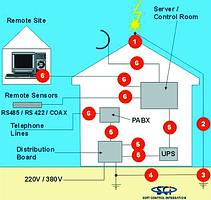

1. Capture the lightning strike
To prevent damage to the building structure and roof-mounted equipment, an air termination network needs to be provided to capture the lightning strike at preferred points.
2. Conduct the strike to the ground safely
Downconductors, capable of carrying the lightning current, should be installed to conduct the lightning strike to ground without the possibility of flash over to extraneous metal work and electrical systems.
3. Low impedance earthing
Provision of low impedance earthing is of major importance to the efficiency of the lightning protection system. It is essential that a low impedance earth be provided to facilitate the dissipation of the lightning energy into the mass of earth as quickly as possible.
4. Eliminate earth loops and differentials
A structure may have several service earths installed that may comprise telephone, electricity supply, communications or special purpose earths. All these may be in addition to the lightning protection earths. When potential differences occur between any of the multiple earths, equipment damage is possible. By providing equipotential bonding to all earths, this problem can be eliminated.
5. Power line protection
If lightning strikes the power lines some distance from the structure, a surge will travel in both directions, including into the structure containing sensitive electronic equipment. This equipment can be protected by the installation of shunt connected surge diverters or inline surge reduction filters.
6. Data line protection
Telephone, communications and signal cables entering a structure (overhead or underground) are subject to induced surges or direct strikes that can also damage the electronic equipment to which they are connected. The protection of such equipment by installing suitable protection devices should be considered.
Lightning - can you afford to ignore it?
Today, computers and computer-based equipment are used extensively in virtually every sector of industry and commerce - as well as hospitals, government facilities, laboratories and banking.
Whether a company operates a local area network, automated factory equipment, a sophisticated building security system, or even a small telephone exchange, it depends totally on that system to operate efficiently.
However, many organisations ignore the single biggest threat to their systems - voltage surges caused by lightning and electrical switching events.
Main power supplies and data communications lines are highly susceptible to surge voltages and the result is usually a total systems failure.
Apart from the enormous cost involved in replacing damaged equipment, consider other expenses that are difficult to quantify: severe disruption to your operations - data loss, downtime, loss of fax machine and telephone, inconvenience to your staff and your customers. But the situation can be avoided.
What happens
Lightning activity near to a building can cause voltage surges (transient overvoltages). These brief but significant increases in voltage on mains power supplies or data communication lines can be conducted into the electronic circuitry of computers and other sensitive electronic equipment. This results in: data loss, loss of fax and phone, system disruption, physical damage to equipment (either immediate or later through component degradation) and costly downtime. Electrical switching events can cause the same problems although chiefly affecting mains power supply.
Is existing protection not adequate?
A conventional lightning protection system will protect only the building structure, not its electronic contents. Equally, uninterruptible power supplies alone cannot protect a computer system against the large voltage surges caused by the secondary effects of lightning. These can be up to 6000 V (3000 A). Indeed, UPSs themselves need protecting from the effects of voltage surges.
For further information contact Hardus Oelofse, Soft Control Integration, 011 315 7710, [email protected]

© Technews Publishing (Pty) Ltd. | All Rights Reserved.